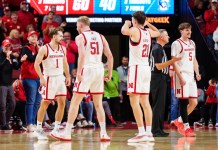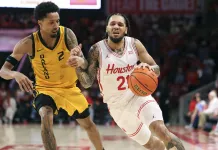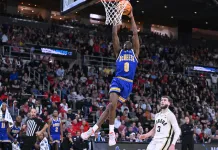Atlantic 10
The Atlantic 10 enters the season looking to continue the momentum from last year when multiple teams – Duquesne and Dayton – made the NCAA tournament. Then both the Dukes and Flyers earned a first-round tournament win.
Key parts from those squads are gone, namely Dae Dae Grant for Duquesne and DaRon Holmes II, the conference’s co-Player of the Year for Dayton, so Virginia Commonwealth gets the nod as the A-10’s top preseason team according to the coaches’ poll.
The Rams are led by 6-foot-5 guard Max Shulga. The fact that Shulga (13.7 PPG) could lift VCU to a championship is not a surprise. Him still wearing a Rams’ jersey, is. In May, the Ukraine native announced he was transferring to Villanova. Less than a month later, he withdrew that commitment and returned to VCU.
Perhaps Shulga had some regrets leaving Ryan Odom, who also previously coached him at Utah State; but not coincidentally, the Rams found some extra NIL money for him right before his change of heart. Whatever it takes to keep a star, especially in the A-10, where one player like Shulga makes a major difference.
Since the A-10 lives somewhere between the Big East and Conference USA, navigating the transfer portal and finding the best way to construct a roster are major yearly decisions these coaches now must make. Some teams will look to rely mostly on continuity (VCU and Loyola Chicago), others are supplementing their roster with key additions for an instant boost (Saint Joseph’s and Dayton) to those basically forming a new squad with a mass influx of transfers (St. Bonaventure and LaSalle).
The most recognizable name, make that goggles, to enter this year is Robbie Avila. The former Indiana State folk hero now calls Saint Louis home along with his coach Josh Schertz and former teammate Isaiah Swope.
Another big name to enter the conference this year will provide zero contributions on the court. It’s juice he will bring to the program. Saint Bonaventure welcomed former ESPN NBA insider Adrian Wojnarowski in the newly formed role of basketball general manager at his alma mater. Even in a mid-major like this, NIL money can shift the balance of power, and schools now have GMs. Welcome to the current state of college basketball.
Davidson
In Matt McKillop’s three campaigns leading the program since his father, Bob, retired, the Wildcats have just a 13-23 record in conference play. Four of its five starters return, namely Connor Kochera and his 13.2 PPG. Reed Bailey and Bobby Durkin will also be back down low again.
In order for Davidson to avoid the bottom portion of the A-10 standings the returners have to provide more offensive production than just their “continuity.” Also, their two main newcomers who arrived on campus via divergent paths. must immediately contribute. The hope is the 6-11 former high school hotshot Joe Hurlburt can break into the starting lineup and be a force after logging just 26 minutes last year for Colorado. In the backcourt, Zach Laput will look to score in the same way he did over his four years at D2 Bentley where he poured in 600 points in back-to-back seasons.
Dayton
DaRon Holmes II is now a Denver Nugget and that means someone else must play the role of leading man for the Flyers.
Anthony Grant will look towards returner Matt Santos or Posh Alexander, now on school number three, to fill that need. Most likely, though, it will be a combination of the two along with the defensive contributions from the 6-foot-3 Enoch Cheeks that will keep the Flyers in contention for a regular season title. Alexander went from St. John’s to Butler where last year once again he led the Big East in steals (71) for the fourth straight season. The point guard position belongs to the talented Malachi Smith, a redshirt junior who has dealt with significant ankle and knee injuries over the past two seasons. The other starting big man position next to Santos, who was named to the A-10’s Preseason First Team, goes to grad transfer Zed Key. Last year, the 6-foot-8 Key averaged 7.4 PPG after returning from a shoulder injury that derailed a strong junior season at Ohio State.
Duquesne
Keith Dambrot and a bulk of seniors, including guards Dae Dae Grant and Jimmy Clark, who combined for over 30 points per game for the Dukes, are gone from a team that made a late run for the conference tournament title and won a first-round NCAA Tournament game.
Now it’s former assistant Dru Joyce’s job to lead a revamped roster that has a preseason look of a middle of the pack team. The Dambrot style was to use a lot of bodies so that should help the returning trio of Kareem Rozier (G), Jake DiMichele (G) and David Dixon (F) settle into their starting roles. Look for Tre Dinkins (15.4 PPG), an All-MAAC performer at Canisius, to quickly find a scoring role. Maximus Edwards (12.4 PPG, 6.6 RPG) shouldn’t have a hard time transitioning into conference play as he was a former A-10 Rookie of the Year at George Washington. Offense, or at least offensive potential, is what will drive the Dukes towards another postseason berth.
Fordham
Sustaining the success Keith Urgo immediately brought to the Bronx in 2023 by winning 25 games has proven to be difficult. Fordham still used its deliberate style and defense last year, but lost 20 games. This year, the Rams are slated for the bottom of the conference standings.
Their main trio of Elijah Gray (now at Temple), Kyle Rose (led the team in scoring 10.8 PPG) and Antrell Charlton (106 assists) are gone. Returnees Japhet Medor, Will Richardson and Abdou Tsimbila must do more than a year ago to even surpass last season’s 10th place finish. Medor, who scored close to 10 points a game last year, will be the primary offensive option and the 6-foot-9 Tsimbila will be one of the A-10’s top shot blockers. Urgo needs his two main transfers who spent time at larger programs – Jackie Johnson (UNLV) and Matt Zona (Notre Dame) – to flourish in a starting role.
George Mason
Last season, the Patriots were somewhat of a surprise in reaching 20 wins, due in large part to an Adjusted Tempo of 63.8, one of the slowest in the country according to KenPom.
Unfortunately for Tony Skinn, that didn’t lead to a postseason appearance after GMU lost its opening conference tournament game. Reaching that goal this year starts with replacing Keyshawn Hall (16.6 PPG, 8.1 RPG) who moved onto UCF and point guard Baraka Okojie, who parlayed his All-Rookie team honors into a new home with Memphis. Shinn will lean on his main outside threat, Darius Maddox (14.0 PPG., 414 3PT), to help GMU’s portal additions adjust to the methodical style that worked so well last season. GMU’s return haul from the portal was a good one. It includes KD Johnson (Auburn), Zach Anderson (Florida Gulf Coast) and Jeremiah Quigley (Iona). This is a good mix of new talent. Johnson (7.8 PPG) has power-conference experience. Anderson (.459 3P%) brings outside shooting while Quigley’s hustle earned him all MAAC Rookie honors. The Patriots look to be in the tier of teams right below the A-10 favorites.
George Washington
This team ended last season in a miserable manner, losing 14 of its last 15 games. It’s difficult to envision a different scenario occurring this season. Garrett Johnson, who missed time last year because of a hip tumor and resulting therapy, tore his ACL over the summer and is out for the year. The inside-outside forward scored over 13 points per game last season. GW will look to rebuild from within by showcasing the 6-foot-7 Darren Buchanan, Jr. (15.6 PPG, 6.6 RPG) and expecting more of an interior presence from the London-born 6-foot-8 sophomore Zamoku Weluche-Ume. He will play alongside two other big men new to the program. The 6-foot-11 Rafael Castro (2.9 PPG) comes over from Providence to team up with the 6-foot-9 Sean Hansen (8.8 PPG) formerly of Cornell. Still without Johnson, the Revolutionaries should finish below .500 in conference play.
La Salle
The A-10 coaches predict the Explorers will finish 15th out of 15 teams. The only reason that may not happen is Fran Dunphy is once again back on the sidelines. For nearly five decades, he has been one of the best coaches in the sport. Over the past two seasons at his alma mater, with limited resources and a turnstile roster, the Explorers have remained competitive (31-36) with three A-10 tournament victories. Last season’s top two players left La Salle to move up the college basketball ladder. Khalil Brantley is now at Oklahoma State and Jhamir Brickus traveled across town to Villanova. Helping to ease this loss is the arrival of the 6-foot-7 Jahlil White (10.1 PPG, 5.5 RPG) from Temple, who is also jumping from one Philly school to another. A pair of other transfers: forward Demetrius Lilly (Penn State) and wing Erick Acker (LIU) should get plenty of time in the starting lineup. Perhaps the best part of this upcoming year for La Salle will be the offseason improvements to the Tom Gola Arena, which previously was one of the worst home courts in the nation.
Loyola Chicago
The Ramblers are experienced, with five major contributors back, and will challenge for a conference title. Drew Valentine needs to keep the progress going that his team showed last year with 23 wins and a share of the regular season title with Richmond. Now that’s the way to bounce back from winning just 10 games prior in the Ramblers’ inaugural A-10 season. Loyola’s guard-heavy lineup welcomes back Des Watson (12.6 PPG, 4.6 RPG), Jayden Dawson (7.9 PPG), Sheldon Edwards (6.0 PPG), Jalen Quinn (4.5 PPG) and 6-foot-10 big man Miles Rubin (2.3 BPG). New to the team and expected to contribute are Justin Moore (12.4 PPG at Drexel), Kymany Houinsou (4.3 ppg with 10 starts at Washington State) and 6-foot-6 freshman Daniil Glaskov from IMG Academy. This gives Loyola some of the best depth in the conference. Also working in Valentine’s favor is Loyola’s location, which can be difficult during A-10 travel season, as the Ramblers lost just one conference home game a year ago.
Massachusetts
The Minutemen have been one of the A-10’s most recognizable programs since the conference began playing basketball in 1976. This year, though, will be its last as a member because the football team is driving the bus to the MAC beginning next season. That means A-10 fans have one last opportunity to see Frank Martin’s intensity on the bench and his team’s physical nature on the court. Before Martin deals with the MAC, he needs to navigate the A-10 after losing his top two backcourt scorers in Matt Cross (SMU) and Josh Cohen (USC) – those two gave the offense over 30 points a game last year. That means holdovers Rahsool Diggins (12.9 PPG), Jaylen Curry (7.4 PPG) and Jayden Ndjigue (5.5 PPG) will man the backcourt. The other two rounding out the starting five should be Daniel Rivera, who averaged over 13 points and eight rebounds at Bryant, and Daniel Hankins-Sanford (5.3 RPG) in the middle. Without Cross and Cohen, it is going to be a lot harder for Martin and crew to once again reach the 20-win mark.
Rhode Island
Archie Miller’s rebuilding project enters Year 3. Two years ago, the Rams struggled to get nine wins. Last year, they bumped it up to 12. In order for that number to make another positive, incremental move in 2025, Miller must do it without former starters Luis Kortright and Zek Montgomery, now at Washington and Bradley, respectively. In total, the Rams program lost seven players. URI’s defense last season was dreadful, finishing 261st in KenPom’s Defensive Adjusted Efficiency. Miller needs his top returning players Jaden House (14.1 PPG) and a healthy David Green (14.3 PPG) to do most of the work on both ends of the court. If the Rams can get to 15 wins, it may quell the growing concerns some in Kingston have that Miller has not turned this program around quick enough.
Richmond
Just when there were some rumblings the Chris Mooney era in Richmond might be coming to an end, the Spiders won 23 games and earned a share of the 2024 regular season title. Tremendously better than the 15-18 record a year before. That type of variance is going to happen in a conference where roster volatility has become the norm. This year, Mooney seemingly starts with a lot less talent. Jordan King, who came to Richmond from ETSU and was the A-10 co-Player of the year, graduated. The same for Neil Quinn. Dji Bailey bolted for LSU.
So here comes a much different starting group for the Spiders. Of course it features transfers. George Washington III (Michigan), Jonathan Beagle (Albany) and Dusan Neskovic (Dartmouth) all must quickly learn from veteran DeLonnie Hunt (9.3 PPG) Mooney’s passing and picking offense.
St. Bonaventure
Regardless of what the Bonnies accomplish this season, all the talk surrounding the program begins and ends with Adrian Wojnarowski serving as their GM. He will see firsthand the seismic movements the portal causes, as the rebuilding Bonnies now have Melvin Council (Wagner), Dasonte Bowen (Iowa) and Chance Moore (Missouri State) among others to replace Chad Venning, Moses Flowers, and Daryl Banks. Mark Schmidt has a reputation of finding ways to fit new players immediately into his defensive schemes. If the Bonnies can claw their way up to a 8-9 seed for the conference tournament at Capital One Arena, it will be a good way to kick off the Woj era in Olean.
Saint Joseph’s
Sticking with the theme of the transfer portal impacting this conference in a major way, the Hawks lost some key names. Gone are starting point guard Lynn Greer, who ventured to crosstown rival Temple and 7-foot center Christ Essandoko, whose continued development will now take place in Providence. This doesn’t mean the Hawks are taking a step back; in fact, their returning star power makes them one of the favorites (+425) to win the conference. Erik Reynolds (17.3 PPG) returns for a fifth year and should challenge for Player of the Year honors. He will pair nicely again with last year’s A-10 Rookie of the Year, Xzayvier Brown (12.7 PPG and 3.3 APG). The A-10 coaches also expect a lot from forward Rasheer Fleming ( 10.7PPG, RPG 7.4) naming him to the preseason All-Conference 3rd Team. Lange acquired Derek Simpson (Rutgers) for his defense and Justice Ajogbor (Harvard) to block shots. The last regular season A-10 title for the Hawks came back in 2005. Their last NCAA tournament appearance was in 2016.
Saint Louis
After the Billikens struggled through a 13-20 record last year, Travis Ford was let go after eight mostly productive seasons. The position directing the Saint Louis program now belongs to Josh Schertz, who turned his Indiana State resurgence into being of the hottest commodities in the job market. The creative NBA offensive philosophies he incorporates immediately make Saint Louis a unique squad in a conference known mostly for grind it out games played in the low 70s.
Schertz is bringing along Robbie Avila who prospered reading and reacting within his offensive sets. The “Larry Blurred” nickname probably goes away but he will still score (17.4 PPG), rebound (6.6 RPG), dish it out (4.1 APG) and stretch the court (39% behind the arc). Also making the move from Terre Haute is guard Isaiah Swope (15.9 PPG). They join Gibson Jimerson (15.8 PPG), already one of the A-10’s best scorers. Returners Kellen Thames and Larry Hughes II, along with transfers such as Kobe Johnson (West Virginia), Kalu Anya (Brown) and AJ Casey (Miami) are all in the position to either start or be key rotational pieces for what should be a Top 25 squad. I have a Saint Louis +450 ticket to win the A-10 already in my portfolio.
VCU
The Rams are the favorite to win the A-10 regular season title according to both bookmakers (+350) and the coaches’ preseason poll. Ryan Odom is looking to prove them right by leveraging an experienced roster that features a star scorer in Max Shulga (.439 3P%). Even though the Rams missed the NCAA Tournament last year, they gained some late season momentum with two NIT victories. Both guards, Zeb Jackson (3.3 APG) and Joe Bamisile (13.1 PPG), are graduate students with the wisdom to know when to score and the time to feed Shulga. All three make up the best backcourt in the conference.
Down low, VCU has the 6-foot-10 long armed Christian Fermin and the well traveled Jack Clark (La Salle, NC State, Clemson) to work the boards. This is a team that at its best provides intense defensive pressure. Because of the expected development of Fermin and sophomore Michael Belle, VCU’s top 40 KenPom defense from a year ago should statisically be even better.






